|
THE FIRST 30 YEARS
Ten months after the last Americans in Vietnam were evacuated
from a Saigon rooftop in April 1975, Robert
Pledge and David
Burnett launched Contact Press Images out of New York
City. Pledge, a French-British journalist specializing in
African affairs, and Burnett, an American who became the last
photographer contracted by Life magazine before its
dissolution in 1972 to cover the war in Southeast Asia, had
been introduced by their common friend, filmmaker and photographer
Raymond Depardon in New York in the summer of 1973 when all
three were associated with the agency Gamma. For both Burnett
and Pledge, the war in Vietnam was formative in shaping their
view of the new generation’s journalistic mission, and
over the next three decades and beyond Contact photographers
would respond to its lessons in ways both explicit and subliminal:
reaffirming the existence of inalienable human rights, the
necessity to question authority, and a sense that history
itself was the true battleground.
I. AFTER VIETNAM: 1976-1988
Contact’s formation in February 1976 coincided with
the Jimmy Carter presidency and the rise of international
concern over human rights and the environment, as well as
sweeping changes in the world of photojournalism. Largely
eclipsed by color television, the standard-bearers of the
black and white photo essay in the US, Life and Look
magazines, had already folded, and Time, Newsweek
and US News & World Report had yet to become
the abundantly-color illustrated weeklies they are today.
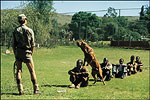 |
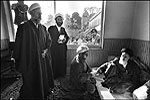 |
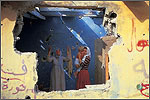 |
| ©
Alon Reininger 1976 |
©
David Burnett 1979 |
©
Frank Fournier 1983 |
Yet
to establish an agency largely dedicated to in-depth color
features when the market for such stories in either color
or black and white hardly existed, in which photographers
would maintain their copyrights and function as auteurs
in the mold of classic photo essayists Robert Capa and W.
Eugene Smith, was Contact’s ultimate goal.
Pledge
and Burnett set up offices on Central Park West in New York
City with a handful of photographers, including Israeli-born
Alon
Reininger, who began to cover apartheid in South
Africa before riots in Soweto drew international attention
(1976), and AIDS in the US in the early eighties when the
disease still had no name; Canadian Douglas Kirkland, famed
for his images of movie icons; and Italian Gianfranco
Gorgoni, who documented the New York art world.
They were soon joined by Rick Smolan, who went on to found
the “Day in the Life” series along with an early
Contact staffer, David Cohen, and Indian native Dilip
Mehta, who in 1977 became one of the first photojournalists
since Margaret Bourke-White's coverage of Mahatma Gandhi for
Life in the late-forties to pierce the veils of Indian
politics and society with his images of Indira Gandhi and
Prime Minister Moraji Desai.
David
Burnett, today one of the world’s most highly esteemed
photojournalists, in many ways served as a model for others
at the agency, mixing peripatetic travels around the world
covering the major events of the day (e.g., the Iranian revolution
in 1979, famine in Ethiopia in 1984, the fall of the Berlin
Wall in 1989), and long term concentration on the powers in
Washington, D.C. through nine presidencies, and the spirit
of sport through six summer Olympic Games. Burnett also pioneered
one of Contact’s hallmarks: the in-depth color feature
shot on the fairly slow Kodachrome 64 film. Longer to process,
but with finer grain, color and tone, the use of this film
in addition to traditional black-and-white Tri-X to cover
news signaled the agency’s philosophy of combining speed
and quality, occasionally sacrificing immediate publication
for something more permanent. A case in point was Burnett’s
image of a Cambodian refugee mother and her child which although
shot for Time could not be used by the magazine because
of the two-day processing time but went on to win the World
Press Photo Premier Award in 1979.
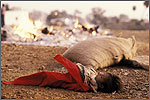 |
 |
 |
| ©
Dilip Mehta 1984 |
©
Alexandra Avakian 1989 |
©
Kenneth Jarecke 1991 |
The
joining of American Annie
Leibovitz in 1977
reaffirmed the agency’s conviction that there was more
to history than “the news.” Leibovitz, then a
young photographer with Rolling Stone in San Francisco,
moved to New York along with the magazine that same year and
was already on her way to redefining American portraiture
– and the concept of celebrity – with her photographs
of John Lennon, Bob Dylan, Andy Warhol, Ray Charles, The Rolling
Stones, and other cultural luminaries.
In its early years the young agency, which had a long-standing
relationship with Time magazine then under the guidance
of picture editor John Durniak, also syndicated the work of
several of the magazine’s renown contract photographers:
Eddie Adams (who was also a member), Michael Evans, Dirk Halstead,
David Hume Kennerly, and Bill Pierce.
Others would round out the core of the small agency during
its first years, including American Chuck Fishman, who documented
the rise of the Solidarity in Poland in 1979; Cuban-born Jose
Azel, who spent nearly a dozen years with the agency; Frank
Fournier, who with four years of medical studies
in his native France behind him deepened Contact’s humanist
commitment with his haunting portrait of Omayra Sanchez, a
thirteen-year-old victim of the Nevado del Ruiz volcano in
Columbia in 1985, rape victims from the war in Bosnia, and
AIDS orphans in Romania; and Kenneth
Jarecke, a Nebraska native, who joined the agency
at the age of twenty and established himself as a consummate
political photographer during the Reagan years before publishing
his book of unflinching personal black and white images from
the first Gulf War during the George Bush, Sr. presidency
(Just Another War, Bedrock Press 1992), some so disturbing
that the American media uniformly refused to print them. The
agency also soon received a fresh infusion of energy with
the joining of Barbara Sadick, who became director of sales,
and Aaron Schindler who assisted with exhibits and special
projects.
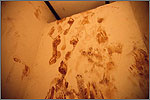 |
 |
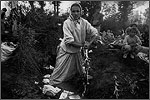 |
| ©
Annie Leibovitz 1994 |
©
Stephen Dupont 1995 |
©
Nadia Benchallal 1995 |
By the time it celebrated its ten-year anniversary in 1986,
Contact’s reputation far exceeded its modest size. Its
photographers’ images had graced the covers of Time,
Newsweek, The New York Times Magazine in the United States,
and had appeared in every major news publication around the
world. The agency’s impact was highlighted in the exhibit,
“Contact: Photojournalism since Vietnam.” Conceived
and organized by Robert Pledge, the exhibition was itself
a watershed event. Preceded by an audio/visual presentation
at the Rencontres d’Arles in July 1986 and at the International
Photography Congress at Maine’s Rockport Opera House
the following month, the 135-image exhibit opened at the International
Center of Photography in the spring of 1987 and went on to
tour twenty-two cities in the US and Canada, and fourteen
more in Europe. It subsequently became the first major showing
of Western photography to appear in the People’s Republic
of China, where it was viewed by tens of thousands of people
a day at the Shanghai Museum of Art and at Beijing’s
National Museum of History between October and November 1988
along with “Life Magazine: 150 Years of Photography”
and “The World Press Photo: 30 Years of Photojournalism,”
both also curated by Pledge. The crackdown by the Chinese
government on democracy activists on Tienanman Square six
months later, and the fall of the Berlin Wall that marked
the end of the Cold War less than half a year afterwards,
ushered Contact into a new phase of development and history.
II. AFTER THE WALL: 1989-2000
In the late eighties and early nineties, the agency broadened
its membership with the addition of American picture editor
Jeffrey
D. Smith – who
joined Contact as director of sales and became a few years
later the agency’s executive director – and added
to its ranks American photographer Lori
Grinker who spent
most of the years since her affiliation with the agency documenting
the lives of twentieth century veterans around the world,
published as the book Afterwar: Veterans From a World
of Conflict (de.MO 2004); Swiss native Tomas
Muscionico (introduced
by his countryman and former Contact contributor, Koni Nordmann)
who documented conflicts in the Balkans, South Africa and
Chechnya, and the rise of world leaders in the nineties —
including Vaclav Havel, Nelson Mandela and Bill Clinton –
before turning his eye toward American fringe groups at the
end of the millennium; Alexandra
Avakian, who in addition to the fall of the Berlin
Wall and the 1989 coup in Moscow against Mikhail Gorbachev,
produced intimate color essays on the first Palestinian
intifada, reforms in Iran, the state of post-Ceaucescu
Romania and newly independent Armenia, all shot for the National
Geographic; and Canadian Greg
Girard, who would document the enormous cultural and political
changes in China, continuing Contact’s long interest
in the People’s Republic that began with its association
with Liu Heung Shing, author of China After Mao (Penguin
1983) in the late seventies.
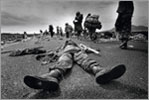 |
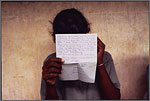 |
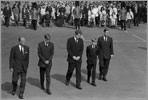 |
| ©
Yunghi Kim 1996 |
©
Lori Grinker 1999 |
©
Patrick Artinian 1997 |
Having
established itself as a major player in the world of photojournalism,
Contact’s second decade would now see the agency broaden
its focus to include fields which had always been close to
its mission: photographic exhibitions and human rights issues.
The former was significantly aided by the office the agency
established in Paris in 1990 to better maintain a European
and international presence and which soon came under the direction
of Dominique
Deschavanne, a French journalist and picture editor.
It was at this time that Contact began to represent select
bodies of work for both distribution and exhibition. These
included the archives of legendary Frenchman Gilles
Caron, whose meteoric career was cut short when
he went missing in Cambodia in 1970 at the age of thirty (the
same age as Olivier
Rebbot – whose
archive Contact represents – when he was mortally wounded
in El Salvador in 1980) and whose images were first presented
as an audio/visual exhibit twenty years after his death at
Arles in 1990; famed British war photographer Don
McCullin, whose retrospective exhibition at Arles
in 1992 and the following year at the Centre Nationale de
la Photographie in Paris were organized by Contact; and the
work of special contributor, Jane
Evelyn Atwood, the Paris-based American documentary photographer
whose seminal work on incarceration, Too Much Time,
was curated by Contact president Robert Pledge at the Maison
de la Villette in Paris in 1998. At this time Contact also
started distributing the work of perhaps the most renown of
all humanist photographers, Brazilian Sebastião
Salgado, produced through the Paris-based agency Amazonas Images he co-founded with Lelia Wanick Salgado in 1994. The following year, Contact began to represent
Li Zhensheng’s
historic archive of images from China’s Cultural Revolution.
In this period Contact’s concern for human rights would
bring it into association with many major government and non-governmental
organizations, including Médecins Sans Frontières/Doctors
Without Borders, with whom it presented an exhibit in Madrid
and Barcelona in 1995-96 celebrating the twenty-fifth anniversary
of the organization; Amnesty International, whose 1998 calendar
was comprised of images from photographers associated with
Contact; and the United Nations, which presented Don McCullin’s
Images of AIDS in southern Africa at its New York headquarters
in 2001. Contact additionally produced the major exhibition
“Keep the Light on Human Rights!” in December
1998 at Tokyo’s Fujita Vente Museum on the occasion
of the fiftieth anniversary of the Universal Declaration of
Human Rights.
 |
 |
 |
| ©
Gilles Caron 1968 |
©
Li Zhensheng 1966 |
©
Don McCullin 1968 |
After opening its offices in Paris, Contact was subsequently
joined by Frenchmen Jean-Claude Coutausse, formerly of the
Paris daily Libération, as well as by his replacement
at the newspaper, Patrick
Artinian; Italian Giorgia
Fiorio, who in the following decade would produce
six books on “Men”; Nadia
Benchallal of France, who since 1989 has focused
on Muslim women around the world; Australian Stephen
Dupont, who became known for his images of conflict
from East Timor, Afghanistan and Indonesia; and South Korean
native Yunghi
Kim, who covered stories of ethnic conflict in
Rwanda and Kosovo, among many others.
From the outset, Contact, because of its international range
of concern, was assisted in distributing its images by agents
throughout the world. Through them Contact photographers achieved
wide exposure in foreign publications in nearly thirty countries.
Many of these agencies, such as Grazia Neri in Italy and IPJ
in Japan have worked with Contact since its inception; others,
such as Focus in Germany and Contacto in Spain, Contact helped
launch.
As Contact Press Images approached the end of the millennium,
and twenty-five years of recording history, the landscape
it surveyed differed greatly from the one that existed when
it began. Color photography, a novelty for covering news in
1976, had long since become the norm. Black and white, by
contrast once the standard, now appeared innovative; and all
film, black and white or color, was quickly being replaced
by digital photography. Most small independent agencies had
disappeared, swallowed by corporate behemoths. And 24/7 live
television coverage and the internet had largely overshadowed
the role traditionally ascribed to photography. But Contact,
with members from a dozen countries, men and women of different
origin, personality and culture, shooting in every format,
from Leicas and Canon digital cameras to inexpensive Holga
cameras, remained independent and committed to a spirit of
activism and humanitarianism guided by its larger historical
project.
III.
AFTER 9/11: 2001-2006
For Contact Press Images, as for much of the world, September
11, 2001 inaugurated a new era, posing new challenges, introducing
new faces, and overnight ushering in a new political and cultural
landscape.
For Contact photographers and staff based in New York City,
9/11 was a day of both tremendous personal grief and professional
activity, as captured in the book Eleven: Witnessing the
World Trade Center 1974-2001 (Rizzoli International/Universe).
Unintentionally reaffirming photography’s unique place
in the world, with airports closed for six days the disaster
simultaneously demonstrated that new technologies, especially
the internet and the digital transmission of images, were
permanent features of the modern world.
 |
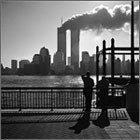 |
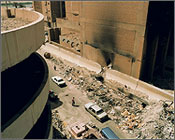 |
| ©
Kristen Ashburn 2002 |
©
Sean Hemmerle 2001 |
©
Sean Hemmerle
2003 |
To
manage the agency’s transition to this new technological
theater while maintaining continuity with its past, Contact
established a digital domain, including a fully updated website,
and scanning and transmitting facilities, run by Dustin Ross in New York and Tim
Mapp in Paris.
The so-called “war on terror”
and its consequences became an obvious preoccupation of the
agency after the destruction of the World Trade Center, and
many of its photographers, including Australian Stephen
Dupont, South Korean native Yunghi
Kim, British writer and photographer Nick Danziger, and famed British war photographer Don
McCullin, subsequently worked in Iraq and/or Afghanistan,
as did two new members, Americans Kristen
Ashburn, winner of the Canon's 2004 Female Photojournalist
Award given annually by the French Association of Women Journalists
(AFJ) for her work on AIDS in southern Africa, and Sean
Hemmerle, who has been documenting the effects of American
military might since 9/11.
In a broader sense, the new global conflict was also considered
by French native Nadia
Benchallal in her decade-long work on women in the Muslim
world, American Alexandra
Avakian, whose story on Muslims in America was produced
for the National Geographic, and Italian Giorgia
Fiorio in her long-term project on “spirituality”
around the world, of which Islam is a major component.
Other additions to the Contact roster in these years included
veteran British photographer Charles
Ommanney, a contract photographer for Newsweek
magazine who covered the Bush White House, and Americans Edward
Keating, a former staff photographer for The New York
Times, and Justin
Guariglia, who specializes in Asia.
Yet despite considerable changes, the agency continued to be
anchored by the work of its veterans, including agency co-founder
David Burnett, Indian Dilip
Mehta, French native Frank
Fournier, Israeli-born Alon
Reininger, American Kenneth
Jarecke, and photographic legends Annie
Leibovitz of the US, who produced Women in 2001,
American Music in 2003, and A Photographer’s
Life 990-2005 in 2006 (all Random House), and Brazil’s Sebastião
Salgado, whose book, The End of Polio (Bulfinch),
appeared in 2003.
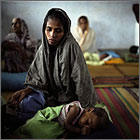 |
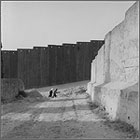 |
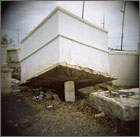 |
| ©
Kristen Ashburn 2005 |
©
Stephen Dupont 2004 |
©
David Burnett
2006 |
Nearing
its thirtieth year, Contact Press Images continued to adapt
to new realities while maintaining its focus on long-term
photographer-driven projects, many of which resulted in books.
Delayed by the events of 2001, but finally published in 2003
was the historic Red-Color News Soldier: A Chinese Photographer’s
Odyssey Through the Cultural Revolution by Li
Zhensheng (Phaidon 2003), which was drawn from negatives
safeguarded for nearly forty years, edited by Robert Pledge,
and written by Li and Jacques
Menasche, a New York-based writer who also collaborated
on Eleven, and has since worked closely with Contact
and many of its photographers on various books, articles,
exhibitions, and special projects. Since translated into six
languages, Red-Color News Soldier was the recipient
of 2004’s Overseas Press Club of America's Olivier
Rebbot "Best Reporting from Abroad" Award, and
has been exhibited in museums throughout the world. Pledge
and Menasche subsequently worked together on Lori
Grinker’s major book, Afterwar: Veterans from
a World in Conflict (de.MO 2004), her fifteen-year project
documenting the lives of frontline veterans of the twentieth
century.
On the occasion of its 30th anniversary, Contact unveiled
a major new collective exhibition, “Contact/s: The Art
of Photojournalism.” Featuring thirty twelve-foot high
contact sheets, the exhibit debuted at the Pingyao International
Photography Festival in Shanxi province, China, in September
2006.
One of the last small independent photographic agencies still
in existence, with just over twenty active photographers from
over a dozen countries, and the archives of another dozen,
the agency’s mission has remained constant: to produce
in-depth photographic essays of pressing global concern instead
of “disposable” news, to pose difficult questions
rather than provide facile answers, and above all to make
important and lasting images – always with history in
mind.
|



